What is an Appendix in a Business Plan?
Appendix is an optional section placed at the end of a document, such as a business plan, which contains additional evidence to support any projections, claims, analysis, decisions, assumptions, trends and other statements made in that document, to avoid clutter in the main body of text.

What is Included in an Appendix of a Business Plan?
Appendix commonly includes charts, photos, resumes, licenses, patents, legal documents and other additional materials that support analysis and claims made in the main body of a business plan document around market, sales, products, operations, team, financials and other key business aspects.
The appendix is the perfect place to showcase a wide range of information, including:
- Supporting documentation: References and supporting evidence to substantiate any major projections, claims, statements, decisions, assumptions, analysis, trends and comparisons mentioned throughout the main body of a business plan.
- Requested documentation: Information, documents or other materials that were specially requested by the business plan readers (e.g., lenders or investors) but are too large to place in the main body of text.
- Additional information: Any other materials or exhibits that will give readers a more complete picture of the business.
- Visual aids: Photos, images, illustrations, graphs, charts, flow-charts, organizational charts, resumes.
After reviewing the appendices, the reader should feel satisfied that the statements made throughout the main body of a business plan are backed up by sufficient evidence and that they got even fuller picture of the business.
How Should You Write a Business Plan Appendix? (Insider Tip)
The fastest way to pull the Appendix chapter together is to keep a list of any supporting documents that come to mind while you are in the process of writing the business plan text.
For example, while writing about the location of your business, you may realize the need for a location map of the premises and the closest competitors, demographic analysis, as well as lease agreement documentation.
Recording these items as you think of them will enable you to compile a comprehensive list of appendix materials by the time you finish writing.
Remember to keep copies of the original documents.
Template: 55 Business Plan Appendix Content Samples
For your inspiration, below is a pretty exhaustive list of supporting documentation that typically gets included in the business plan appendix. But please do not feel like you have to include everything from the list. In fact, you definitely shouldn’t!
The purpose of the appendix is to paint a fuller picture of your business by providing helpful supporting information, not to inundate yourself or the readers of your business plan. So, take care to only include what is relevant and necessary .
Company Description
1. Business formation legal documents (e.g., business licenses, articles of incorporation, formation documents, partnership agreements, shareholder agreements)
2. Contracts and legal agreements (e.g., service contracts and maintenance agreements, franchise agreement)
3. Intellectual property (e.g., copyrights, trademark registrations, licenses, patent filings)
4. Other key legal documents pertaining to your business (e.g. permits, NDAs, property and vehicle titles)
5. Proof of commitment from strategic partners (e.g., letters of agreement or support)
6. Dates of key developments in your company’s history
7. Description of insurance coverage (e.g. insurance policies or bids)
Target Market
8. Highlights of relevant industry and market research data, statistics, information, studies and reports collected
9. Results of customer surveys, focus groups and other customer research conducted
10. Customer testimonials
11. Names of any key material customers (if applicable)
Competition
12. List of major competitors
13. Research information collected on your competitors
14. Competitive analysis
Marketing and Sales
15. Branding collateral (e.g., brand identity kit designs, signage, packaging designs)
16. Marketing collateral (e.g., brochures, flyers, advertisements, press releases, other promotional materials)
17. Social media follower numbers
18. Statistics on positive reviews collected on review sites
19. Public relations (e.g., media coverage, publicity initiatives)
20. Promotional plan (e.g., overview, list and calendar of activities)
21. List of locations and facilities (e.g., offices, sales branches, factories)
22. Visual representation of locations and facilities (e.g., photos, blueprints, layout diagrams, floor plans)
23. Location plan and documentation related to selecting your location (e.g., traffic counts, population radius, demographic information)
24. Maps of target market, highlighting competitors in the area
25. Zoning approvals and certificates
26. Detailed sales forecasts
27. Proof of commitment from strategically significant customers (e.g., purchase orders, sales agreements and contracts, letters of intent)
28. Any additional information about the sales team, strategic plan or process
Products and Services
29. Product or service supporting documentation – descriptions, brochures, data sheets, technical specifications, photos, illustrations, sketches or drawings
30. Third-party evaluations, analyses or certifications of the product or service
31. Flow charts and diagrams showing the production process or operational procedures from start to finish
32. Key policies and procedures
33. Technical information (e.g., production equipment details)
34. Dependency on third-party entities (e.g., materials, manufacturing, distribution) – list, description, statistics, contractual terms, rate sheets (e.g., sub-contractors, shippers)
35. Risk analysis for all major parts of the business plan
Management and Team
36. Organizational chart
37. Job descriptions and specifications
38. Resumes of owners, key managers or principals
39. Letters of reference and commendations for key personnel
40. Details regarding human resources procedures and practices (e.g., recruitment, compensation, incentives, training)
41. Staffing plans
42. Key external consultants and advisors (e.g., lawyer, accountant, marketing expert; Board of Advisors)
43. Board of Directors members
44. Plans for business development and expansion
45. Plan for future product releases
46. Plan for research and development (R&D) activities
47. Strategic milestones
48. Prior period financial statements and auditor’s report
49. Financial statements for any associated companies
50. Personal and business income tax returns filed in previous years
51. Financial services institutions’ details (name, location, type of accounts)
52. Supporting information for the financial model projections, for example:
- Financial model assumptions
- Current and past budget (e.g., sales, marketing, staff, professional services)
- Price list and pricing model (e.g., profit margins)
- Staff and payroll details
- Inventory (e.g., type, age, volume, value)
- Owned fixed assets and projected capital expenditure (e.g., land, buildings, equipment, leasehold improvements)
- Lease agreements (e.g., leases for business premises, equipment, vehicles)
- Recent asset valuations and appraisals
- Aged debtor receivable account and creditor payable account summary
- Global financial considerations (exchange rates, interest rates, taxes, tariffs, terms, charges, hedging)
53. Debt financing – documentation regarding any loans, mortgages, or other debt related financial obligations
54. Equity financing – capital structure documentation (e.g., capitalization table, 409A, investor term sheets, stock and capital related contracts and agreements)
55. Personal finance – information regarding owners’ capital and collateral (e.g., Personal Worth Statement or Personal Financial Statement, loan guarantees, proof of ownership)
Related Questions
How do you finish a business plan.
Business plan is finished by summarizing the highlights of the plan in an Executive Summary section located at the beginning of the document. The business plan document itself is finished by an Appendix section that contains supporting documentation and references for the main body of the document.
What is bibliography?
A bibliography is a list of external sources used in the process of researching a document, such as a business plan, included at the end of that document, before or after an Appendix. For each source, reference the name of the author, publication and title, the publishing date and a hyperlink.
What are supporting documents included in a business plan appendix?
Supporting documents in a business plan appendix include graphs, charts, images, photos, resumes, analyses, legal documents and other materials that substantiate statements made in a business plan, provide fuller picture of the business, or were specifically requested by the intended reader.
Sign up for our Newsletter
Get more articles just like this straight into your mailbox.
Related Posts
Recent posts.
🎧 Real entrepreneurs. Real stories.
Subscribe to The Hurdle podcast today!
What to Include in Your Business Plan Appendix

Candice Landau
4 min. read
Updated July 11, 2024

While not required, a well-structured business plan appendix goes a long way toward convincing lenders and investors that you have a great business idea and a viable business.
This article will cover what should be part of the appendix in your business plan and best practices for making it a useful part of your business plan .
- What is a business plan appendix?
A business plan appendix provides supporting documentation for the other sections of your business plan .
The appendix for business plans typically comes last and includes any additional documents, spreadsheets, tables, or charts that don’t fit within the main sections of your plan.
What goes in the appendix of a business plan?
In general, here is some of the information you might include in your business plan appendix:
- Charts, graphs, or tables that support sections of your business plan
- Financial statements and projections
- Sales and marketing materials
- Executive team resumes
- Credit history
- Business and/or personal tax returns
- Agreements or contracts with clients or vendors
- Licenses, permits , patents, and trademark documentation
- Product illustrations or product packaging samples
- Building permit and equipment lease documentation
- Contact information for attorneys , accountants, and advisors
You may include some, all, or none of these documents in your business plan appendix. It depends on your business needs and who you share your business plan with.
Tip: Like your executive summary , adjusting what’s in your business plan appendix may be helpful based on the intended audience. For example, if you’re applying for a loan, you may add financial statements from the past 2-5 years to show how your business has performed.
Brought to you by
Create a professional business plan
Using ai and step-by-step instructions.
Secure funding
Validate ideas
Build a strategy
Business plan appendix best practices
Here are a few tips to help you create an appendix for your business plan.
Make it easy to navigate
If your business plan appendix is more than a few pages long or contains a variety of documents, you may want to consider adding a separate table of contents.
Don’t forget security
If you share confidential information within the business plan appendix, you will also want to keep track of who has access to it.
A confidentiality statement is a good way to remind people that the content you share should not be distributed or discussed beyond the agreed parties. You can include it as a separate page or as part of your business plan cover page .
Make the appendix in your business plan work as a separate document
Given that the appendix is the last part of the business plan, it’s quite likely your readers will skip it.
For this reason, it’s important to ensure your business plan can stand on its own. All information within the appendix should be supplementary.
Ask yourself: if the reader skipped this part of my plan, would they still understand my idea or business model ? If the answer is no, you may need to rethink some things.
Connect the appendix to sections of your business plan
Make sure that anything you include in the business plan appendix is relevant to the rest of your business plan. It should not be unrelated to the materials you’ve already covered.
It can be useful to reference which section of your plan the information in your appendix supports. Use footnotes, or if it’s digital, provide links to other areas of your business plan.
Keep it simple
This is good general advice for your entire business plan.
Keep it short.
You don’t need to include everything. Focus on the relevant information that will give your reader greater insight into your business or more detailed financial information that will supplement your financial plan.
Free business plan template with appendix example
Remember, your appendix is an optional supporting section of your business plan. Don’t get too hung up on what to include. You can flag documents and information you believe are worth including in your appendix as you write your plan .
Need help creating your business plan?
Download our free fill-in-the-blank business plan template with a pre-structured format for your appendix.
And to understand what you should include based on your industry—check out our library of over 550 business plan examples .
Business plan appendix FAQ
How do you write an appendix for a business plan?
Gather relevant documents like financial statements, team resumes, and legal permits. Organize them logically, possibly mirroring your business plan’s structure. If long, include a table of contents, ensure each item is relevant, and focus on keeping it simple. If you’re sharing sensitive information, add a confidentiality statement.
Why is a business plan appendix important?
An appendix in your business plan provides supporting evidence for your business plan. It keeps your main plan more concise, enhances credibility with additional data, and can house all-important business documents associated with your business.
What additional information would appear in the appendix of the business plan?
The following can appear in your business plan appendix:
- Financial projections
- Marketing materials
- Team resumes
- Legal documents (like permits and patents)
- Product details (like prototypes and packaging)
- Operational documents (like building permits)
- Professional contact information.
Candice Landau is a marketing consultant with a background in web design and copywriting. She specializes in content strategy, copywriting, website design, and digital marketing for a wide-range of clients including digital marketing agencies and nonprofits.

Table of Contents
- What goes in the appendix?
- Best practices
- Free template
Related Articles

10 Min. Read
How to Write a Competitive Analysis for Your Business Plan

How to Set and Use Milestones in Your Business Plan

24 Min. Read
The 10 AI Prompts You Need to Write a Business Plan

How to Write the Company Overview for a Business Plan
The LivePlan Newsletter
Become a smarter, more strategic entrepreneur.
Your first monthly newsetter will be delivered soon..
Unsubscribe anytime. Privacy policy .

The quickest way to turn a business idea into a business plan
Fill-in-the-blanks and automatic financials make it easy.
No thanks, I prefer writing 40-page documents.

Discover the world’s #1 plan building software
- Business Consulting
Business Plan Appendix: A Step-by-Step Guide

Written by Vinay Kevadiya
Published Nov. 25 2024 · 10 Min Read
Often overlooked appendix in a business plan is an unsung hero that brings your vision to life in ways the main document simply can't.
Using the appendix to its full potential, you can empower your business plan to tell a complete story with supporting facts, giving readers confidence in your vision. However, creating a powerful appendix requires a systematic approach.
It's not just about gathering documents; it's about presenting them in a way that reinforces the strength of your business plan. A well-organized appendix can captivate stakeholders and provide the additional details they need to fully trust your vision.
But where do you begin? How do you decide what goes in first, and how can you ensure the appendix remains easy to navigate? Don't worry—this blog will answer all your questions.
Let's dive in.
What is an appendix in a business plan?
An appendix in a business plan is a supplementary section that provides additional information to support the main body of content of the plan.
It includes documents, charts, graphs, and other relevant materials that can help clarify or provide evidence for the statements made in the business plan.
This section is handy for presenting data that needs to be longer or more complex to include in the main body, such as:
- Financial statements
- Resumes of key team members
- Market research findings
- Legal agreements
In short, it acts as a reference library, offering extra details when needed without distracting from the business plan's core message.
Why do you need a business plan appendix?
The appendix in a business plan is more than just an optional section; it plays a crucial role and can be a game-changer for many businesses.
What to include in the business plan appendix?
If you're unsure about what to include in the appendix, you might miss out on maximizing its benefits. Below are some key aspects to consider, along with detailed explanations of their importance:

Financial statements:
Investors and lenders rely on these statements to assess your business's viability and profitability. It also gives stakeholders confidence in your ability to manage finances effectively (important to acquire funding).
Include detailed financial projections such as:
- Income statements
- Balance sheets
- Cash flow statements
- Bank statements
Legal documents
Including legal documents demonstrates your business operates within legal boundaries and has protected its intellectual property.
- Business registration and licenses
- Tax documents
- Intellectual property rights (patents, trademarks)
- Contracts or agreements with suppliers, partners, or clients
Market research & analysis
This section showcases your understanding of the market and validates your business model. It demonstrates you’ve done your homework on industry trends, intended audience, target customers, and competition.
- Industry reports
- Customer surveys or focus group results
- Competitor analysis
- Market sizing data
Product or service information
Providing detailed descriptions of your products or services helps investors understand what you’re offering and how it stands out in the market.
- Product photos or designs
- Product development timelines
- Technical specifications
- Case studies or testimonials from customers
Compliance documents
Including compliance documentation is crucial for businesses operating in regulated industries. This section shows you’re adhering to relevant laws and standards.
- Industry-specific certifications
- Environmental or safety compliance documents
- Regulatory approvals
The appendix in a business plan is essential for providing supporting documents that validate your claims and give stakeholders confidence in your vision and possible success.
Here are some data and documents you’ll consider including in the appendix and how they make your appendix important:

Including legal documents in your appendix demonstrates that your company operates within legal boundaries and has protected its unique ideas, reducing potential risks for investors.
Here’s what you can include in legal documents:
- Business registration certificates
- Operating licenses
- Articles of incorporation
- Partnership agreements
- Intellectual property documents (e.g., trademarks, copyrights, patents)
Market research data
This data validates your market strategy and shows a deep understanding of your target audience, competitors, and industry trends, which builds trust with stakeholders.
Include the following documents for market research:
- Research chart
Team resume
Adding a team resume in the appendix proves that your team has the skills and experience to execute the business plan successfully.
It provides stakeholders with a clear understanding of the expertise driving the business, which boosts their confidence in you.
You should attach the following documents to the team resume:
- Team members experience letter
- Certificate of qualifications
- Special expertise certification
- Awards and recognitions
Business contracts and agreements
Showcase existing relationships and commitments in your appendix. This reassures investors about the stability and future growth of your business.
Attach documents such as:
- Signed contracts with suppliers
- Lease Agreements
- Customer Agreements
- Partnership Agreements
Regulatory compliance documents
The appendix is an ideal section to showcase your compliance documents without disrupting the flow of your core business plan.
Your regulatory compliance should include:
- Documentation of permit
- Tax registration certificates
- Environmental compliance reports
How to organize your appendix in a business plan?
An appendix can significantly enhance your business plan, but only if it's well-organized and easy to navigate. Here's how you can plan and write your appendix:

1) Start with the table of content
The appendix should begin with a clear and concise table of contents. This allows readers to see at a glance what documents are included and where to find them.
Further, a table of contents can help readers navigate the content easily and save time for stakeholders who may only need specific details.
Here’s an example to make your understanding precise:
2) Group similar documents together
Grouping similar documents helps maintain a logical flow, making it easier for readers to review related information in one place.
Hence, organize the appendix by grouping related documents into sections. Common categories include:
- Financial documents: Income statements, balance sheets, and cash flow projections.
- Legal documents: Business licenses, permits, and partnership agreements.
- Team credentials: Resumes, certifications, and awards.
- Contracts: Supplier agreements, customer contracts, and lease agreements.
3) Label each document clearly
Each document should have a clear title or label. Clear labels eliminate confusion and help readers understand the purpose of each document at a glance.
For example, instead of "Contract," specify "Supplier Contract with ABC Corp." Additionally, include page numbers on each document for easy referencing.
Label your documents as shown below:
- Supplier Contract with ABC Corp.
- Financial Projection for FY 2024
- Marketing Agreement with XYZ Agency
- Lease Agreement for Office Space at 123 Main Street
4) Include summaries or descriptions
For complex documents, provide a brief summary or description. For example, if you’re including a financial projection, summarize the key takeaways and how they align with your business goals.
Example: Financial projections
This document outlines our financial projections for the next fiscal year, including projected revenue, expenses, and profit margins. Key highlights:
- Expected revenue growth of 25% by Q3.
- Anticipated net profit of $500,000 for FY 2024.
- Operating costs are expected to decrease by 10% due to streamlined processes.
These projections demonstrate the business’s strong financial health and growth potential, aligning with our strategy to scale operations.
Remember: Not every reader will have the time or expertise to analyze detailed documents. Summaries provide context and highlight the most important points.
5) Maintain professionalism
Ensure that all documents in the appendix are well-formatted and free of errors. Use consistent fonts, clear headings, and professional language.
Here are a few tips that you can use to craft your appendix professionally:
- Use a consistent font style and size to maintain uniformity throughout.
- Apply Clear, Descriptive Headings to make it easy to identify sections.
- Protect confidential data while still providing necessary details.
- Ensure documents are free from typos and inaccuracies.
- Facilitate easy referencing.
A polished appendix reflects your attention to detail and professionalism, which can positively influence stakeholders' perceptions of your business.
6) Reference the appendix in the main page
To maximize the usefulness of your appendix, it's essential to reference it within your main business plan wherever relevant. This strategy strengthens your main document and encourages readers to explore the additional resources in the appendix.
Whenever you mention data, agreements, or detailed projections in the main plan, guide the reader to the appendix for further details.
Here's how:
Financial Projections:
In the financial section, if you outline expected revenue growth, add a note:
“For a detailed breakdown of financial projections, see Appendix, Page 1.”
Legal Documents:
When discussing your legal structure, you could state:
“Relevant licenses and permits can be found in Appendix, Page 5.”
Team Information:
Highlight your team's expertise by adding:
“Detailed resumes of key team members are available in Appendix, Page 10.”
Cross-referencing shows that your claims and data are backed by detailed documents, making your business plan more credible.
Further, it allows readers to access supplementary information without cluttering the core content, ensuring the main plan remains concise and focused.
Remember, the appendix isn’t just an optional add-on; it’s an essential component that elevates the quality of your business plan and strengthens its overall impact. By including well-organized supporting documents, you provide clarity and build trust with stakeholders.
For more tips on crafting a top-notch business plan, check out our guide on key qualities of an effective business plan .
Bottom line
After reading this blog, it’s clear that the appendix is not just a collection of documents but the backbone of your business plan. It strengthens your plan’s credibility, provides essential support, and helps you stand out to stakeholders.
We’ve covered everything from understanding an appendix to deciding what to include and how to manage it effectively.
However, creating a strong appendix requires careful planning and precision. Our team of experienced business plan consultants at PlanGrow Lab specializes in building well-structured appendices that enhance the overall quality of your business plan, ensuring it’s comprehensive and well-researched.
Contact our experts today to craft a compelling appendix that supports your vision!
Frequently Asked Questions
How long should a business plan appendix be?
Typically, appendices range from a few pages to 20+ pages, depending on the industry and audience. However, the length of the appendix varies depending on the complexity of your business and the amount of supporting documentation required.
Is the appendix mandatory for a business plan?
While not mandatory, an appendix is highly recommended. It provides additional details and evidence that support the main plan without cluttering its core sections.
Investors, lenders, and stakeholders often appreciate having access to more in-depth information to validate your claims, such as financial projections, legal documents, and market research.
How should I organize the documents in the appendix?
Organize your appendix logically and systematically. Start with a table of contents to make navigation easy. Group similar documents together (e.g., financial documents, legal agreements, team information) and label each document clearly. Include page numbers and descriptive headings to help readers quickly locate specific information.
Do I need to update the appendix regularly?
Yes, the appendix should be updated regularly to reflect the most current information. As your business evolves, new financial data, legal documents, or contracts may become relevant. Keeping the appendix up-to-date ensures that stakeholders always have access to accurate and reliable information.

As the founder and CEO of Upmetrics, Vinay Kevadiya has over 12 years of experience in business planning. He provides valuable insights to help entrepreneurs build and manage successful business plans.
Follow Vinay Kevadiya

Appendix: A Sample Business Plan
The following business plan for Frank’s All-American BarBeQue was built using Business Plan Pro software. It is for the purpose of illustration and does not represent the full capabilities of the software.
Executive Summary
Frank’s All-American BarBeQue has operated for decades in the southern Connecticut shore region. With a tradition of superlative food at fair prices served in a family-friendly atmosphere, the owners now believe it is time to open a second restaurant and expand the production and the distribution of Frank’s signature barbecue sauces. This second restaurant will be in Darien, Connecticut, and will be nearly twice as large, in terms of seating capacity, as the current Fairfield restaurant. The company also plans to ramp up production of its sauces and increase their sales fourfold in the next three years.
The owners of Frank’s All-American BarBeQue and other investors plan to put $160,000 of their own money into the second restaurant and expand the production of the signature sauces. They seek to raise an addition $175,000 from a bank loan that will be repaid in two years.
Vision Statement
To produce the best barbecue food in New England.
Mission Statement
The mission of Frank’s All-American BarBeQue is to provide the southern Connecticut shore region with the finest barbecue food in four major regional styles at affordable prices in a family-friendly setting. As we grow, we will never forget and remain faithful to those factors that have made us a success.
Keys to Success
Frank’s All-American BarBeQue has been in business for nearly forty years. It has weathered good times and bad times through all types of economic conditions. We have survived because Frank’s has remained committed to several principles.
- The only objective of a restaurant is to serve the finest food it can prepare. Good food—not more gimmicks or advertising—brings in customers and, more importantly, keeps customers.
- Preparing the finest foods means a commitment to excellence, which means obtaining the best ingredients and a dedication to cooking barbecue properly, which means cooking carefully and slowly .
- In addition to providing the finest food, we remain committed to providing excellent service. To us, this means friendly and knowledgeable staff members who make the customers feel like they are dining with family.
- We provide the right atmosphere. Our goal is to have a setting that says “barbecue.” We do not provide a fancy setting; our basic setting complements the food we serve.
Company Summary
Frank’s All-American BarBeQue has been a highly successful restaurant in Fairfield, Connecticut, for nearly forty years. It was started and is still managed by Frank Rainsford. Its food and sauces have won awards at both regional and national barbecue cook-offs. In addition, Frank’s has been voted the best barbecue establishment in Connecticut numerous times by many local newspapers and magazines.
The management team of Frank’s All-American BarBeQue has decided that now is the time to expand to an additional location. After careful analysis, a second Frank’s All-American BarBeQue can and should be opened in Darien, Connecticut. This restaurant will be larger and geared to better tap into the growing premade, take-home dinner market.
In the last few years, Frank’s has been selling its four signature barbecue sauces—Texan, Memphis, Kansas City, and Carolina—in local supermarkets. Although this represents a small portion of overall revenues, sales have been growing at a remarkable pace. This market must be exploited. Preliminary market research indicates that this segment of the business will grow at 20 percent per year for the next five years.
Company Ownership
Presently, Frank’s All-American BarBeQue is a limited liability partnership with Frank Rainsford and his wife Betty as owners. Each has a 50 percent share in the business.
The plans for expansion will bring in capital from three other investors: Robert Rainsford, Susan Rainsford Rogers, and Alice Jacobs. Robert Rainsford and Susan Rainsford Rogers are the son and daughter of Frank and Betty. Both have extensive work experience at Frank’s. Alice Jacobs has been the restaurant’s accountant for over twenty years.
To assist the financing of the expansion, Robert Rainsford and Susan Rainsford Rogers will each invest $50,000, while Alice Jacobs will invest $60,000.
The new limited liability partnership will result in the investors holding the following equity percentages:
Company History
Frank’s All-American BarBeQue was founded in 1972 by Frank Rainsford. Although a native New Englander, Frank learned about cooking barbecue while serving in the US Air Force. During his twelve years of service, he traveled across the country and learned about the four major styles of American barbecue—Texas, Memphis, Kansas City, and Carolina. His plan was to introduce people in southern Connecticut to real barbecue that entailed high-quality meats properly cooked and smoked over an appropriate length of time.
In the beginning, Frank’s All-American BarBeQue was a small facility; it could seat about thirty people. It was located near the Fairfield railroad station and was the first full-service barbecue restaurant in Fairfield. Frank’s placed an emphasis on featuring the food; it had a highly simplified decor where the tables were covered with butcher paper, not linen tablecloths. The restaurant was an immediate hit, received considerable local press, and won several food awards. This success enabled Frank’s to move to a larger facility in Fairfield on the town’s main thoroughfare—Boston Post Road. The new location was a midsize restaurant of about eighty seats. Frank has built this location into a relatively successful and locally well-known enterprise. It has been at the present location since the early 1980s. It shares a parking lot with several other stores in the small mall in which it is located.
Frank’s has won many awards at regional and national barbecue cook-offs (for both the food and the sauces), which is unusual for a barbecue business in New England. The restaurant has been written up, repeatedly, in the local and New York papers for the quality of its food and its four signature barbecue sauces. In the last few years, Frank’s has sold small lots of these sauces in local supermarkets. They have been distributed because of Frank’s personal connections with the store managers. Frank Rainsford has been approached by a major regional supermarket to sell his sauces. The supermarket is willing to find a facility that could produce Frank’s sauces in significantly larger volumes, which would represent a substantial increase in the sales of sauces. “Past Performance of Frank’s All-American BarBeQue” provides a summary of key financial figures for the last three years—2008 to 2010. “Past Performance Chart” illustrates these key numbers for that period of time.
Past Performance of Frank’s All-American BarBeQue
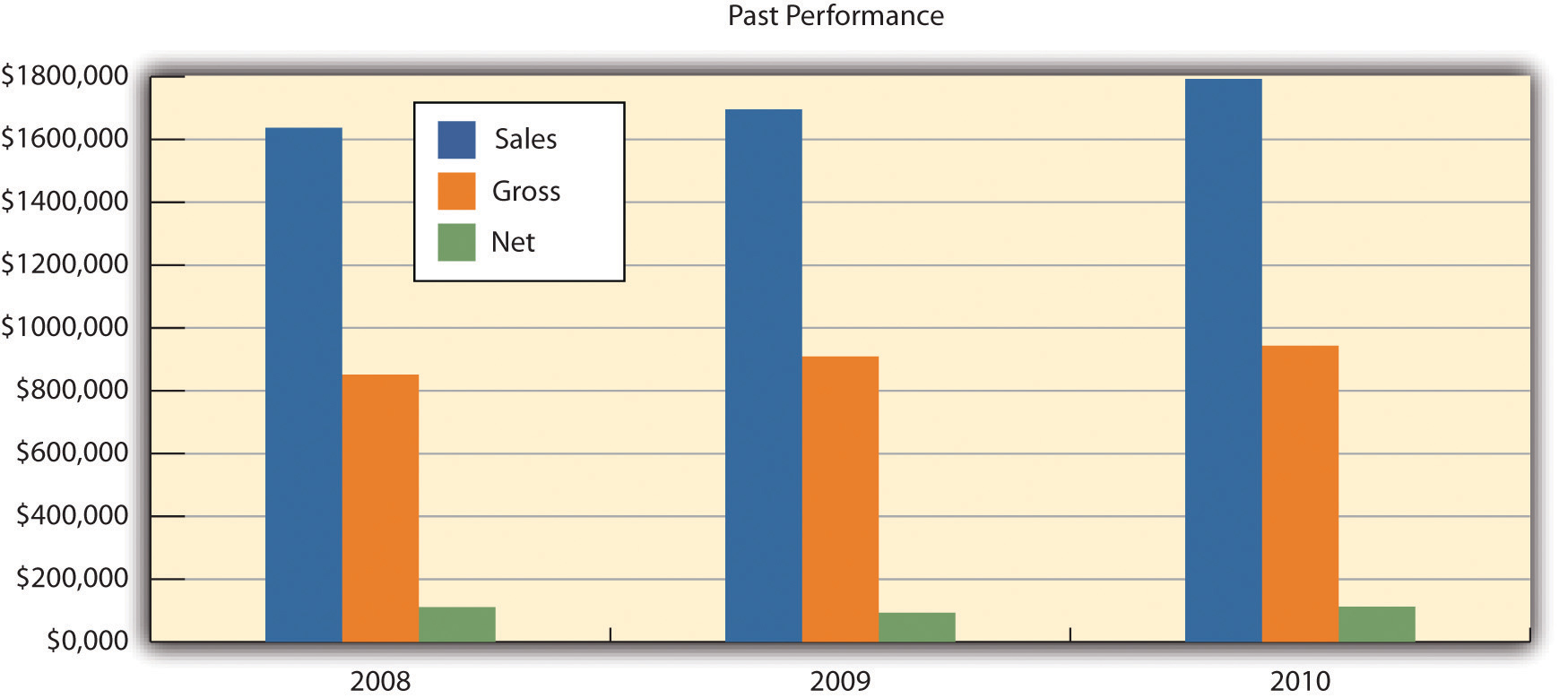
Company Locations and Facilities
Frank’s All-American BarBeQue has been in Fairfield, Connecticut, for decades. It has a reputation throughout the southern Connecticut shore region for excellent food and has received numerous awards. The management team determined that a second location could tap into this local name recognition. Several towns in the region were evaluated for total population, population density, family income, and home value. These factors were considered because of their impact on generating traffic and consumers being able to pay for meals that are priced slightly higher than typical fast-food outlets. In addition, the average family size and the percentage of family households were considered because Frank’s is a family restaurant. Lastly, data were gathered on the average travel time to and from work for residents and the real estate tax rate. Because the new location of Frank’s will emphasize prepared meals, we felt that individuals with longer commutes would be more likely to order meals and pick them up at Frank’s. A summary of these data is provided in “Demographic Data for Selected Connecticut Towns—Part 1” and “Demographic Data for Selected Connecticut Towns—Part 2”.
After thorough analysis, it was concluded that Darien, Connecticut, would be the best location for the new branch of Frank’s All-American BarBeQue. It has a high-income population and a high population density, and a large percentage of its inhabitants are members of family households. They have longer commuting times, which increase the potential need for prepared meals.
Demographic Data for Selected Connecticut Towns—Part 1
Demographic Data for Selected Connecticut Towns—Part 2
A specific location has been identified in Darien for the second Frank’s All-American BarBeQue. It is in a small mall and is large enough to have a seating capacity of 150–160 plus takeout facilities. The mall has more than adequate parking for future customers. The mall is located three blocks from the Metro-North Darien railroad station and is four blocks from the I-95 exit. It is therefore well-positioned to attract traffic from both car and rail commuters. The lease fee for a three-year contract is very reasonable for a property of this size.
Products and Services
Frank’s All-American BarBeQue specializes in the finest barbecue served in a family-friendly format. It uses the finest cuts of meats that are free of any growth hormones. It is known for a variety of slow-smoked and slow-cooked meats, such as ribs, beef, pulled pork, and chicken. These are served with Frank’s famous and award-winning sauce varieties, which represent the four major styles of barbecue cooking. Frank’s is also noted for its side dishes and desserts.
Our goal is to expand operations to a second location in Darien, Connecticut. This outlet will be significantly larger and will have a section devoted to takeout meals.
Competitive Comparison
There are approximately forty specialty barbecue restaurants in Connecticut. They are spread throughout the state, but only four (including Frank’s All-American BarBeQue) are in the southern shore region. The three competitors are smaller operations. None of the barbecue restaurants in Connecticut have the history, reputation, acclaim, or awards that match Frank’s All-American BarBeQue. It is not an exaggeration to say that Frank’s is the preeminent barbecue restaurant in Connecticut. It has a loyal following that reaches as far as New York City.
Frank’s is the only barbecue restaurant in Connecticut where supermarkets are vying for the right to market Frank’s signature barbecue sauces. This sideline business promises to be extremely profitable and support the overall marketing efforts for both locations of Frank’s All-American BarBeQue.
Fulfillment
Frank’s All-American BarBeQue has always been committed to providing the absolute best in barbecue food. This has meant assuring the highest quality ingredients in food preparation. Frank has established a decades-long relationship with suppliers in the New York and Connecticut areas. He selects nothing but the choicest selections of beef, pork, and chicken. He has always made sure that his meats come from suppliers who are committed to quality ingredients and who never use growth hormones. This long-term relationship with a variety of key suppliers enables Frank to secure the best cuts at reasonable prices. Frank is equally careful in using the finest spices for his barbecue sauces. The same is true for all the side dishes that Frank’s All-American BarBeQue offers its customers.
This commitment to quality is not limited to the selection of meats and ingredients. Frank and his staff recognize that top-quality barbecue food requires a knowledgeable and deep commitment to cooking the food properly. All meats must be cooked and smoked slowly. This requires time, effort, expense, and commitment, but the results are spectacular. Some cuts of meat at Frank’s may require as many as eleven hours of preparation and cooking. Excellence is not achieved without a commitment to effort. This effort has been recognized with numerous awards at national barbecue cook-offs. Frank has clearly recognized that the meal is clearly a function of the quality of the meat, quality ingredients, and careful preparation.
Future Products and Services
Frank’s All-American BarBeQue is ready to accept new challenges. Opening a second restaurant will significantly increase sales, but the second location is only the beginning of new directions for Frank’s. Although Frank has been selling his regional barbecue sauces in local outlets for years, he is now ready to sign a contract with a major regional supermarket chain to market and sell these sauces throughout New England. Preliminary studies indicate that Frank can anticipate a 20 percent annual growth rate in the sales of sauces for the next five years.
With the growth of two-income families, less and less time is available to prepare meals at home. Recognizing this simple fact, Frank’s All-American BarBeQue plans to offer a variety of prepackaged barbecue meals that can be picked up at the restaurant and reheated at home. As part of its new commitment to a web-based presence, customers will be able to order these meals by regular phone, with smartphones, or through the Internet. Customers will be able to select from a list of prepackaged dinner meals or any combination of items. Customers can designate the time to pick up the meals, and the meals will be ready for them. This service promises significant revenue growth.
Market Analysis Summary
Since the 1930s, the American public has spent at least 5 percent of its disposable income on eating out. Even with annual fluctuations, this is a strong indicator of the viability of this industry. This can be best illustrated by reviewing industry results for the last few years.
Both 2009 and 2010 were difficult years for the restaurant industry. In 2008, sales increased by 3.8 percent. However, sales fell by nearly 0.75 percent in 2009. This was the first year in the history of the industry that sales actually declined. The restaurant industry’s sales in 2009 were $566 billion, down from over $570 billion. Prices rose by 2.2 percent in 2009. The increase in sales for 2010 was 0.5 percent, and price increases stabilized at 0.75 percent.
It is anticipated that there will be significant price competition in every segment of the restaurant industry. Some analysts argued that the poor performances for the restaurant industry in both 2009 and 2010 could be attributed to declines in both business and personal travel. Hotel occupancy rates in 2009 were down by nearly 10 percent. A study conducted by the National Restaurant Association argued that 20 percent of the sales in casual dining restaurants might be due to travelers and visitors. Frank’s All-American BarBeQue relies to a far lesser extent on travelers as customers. A rough estimate based on credit card receipts, for the period 2006–2010, indicated that travelers represented less than 2 percent of Frank’s sales. The pressure on the restaurant industry has been felt by many chain restaurants, which significantly curtailed their expansion plans.
Even though the recession was in full bloom in 2009, many food prices rose and rose significantly. Beef prices rose between 4 percent and 12 percent, while pork prices rose between 5 percent and 13 percent. Numerous studies have indicated that the increase in commodity prices will not be a transitory phenomenon.
With 925,000 food service locations in operation in the United States, this translates into 1 restaurant for every 330 Americans.
The health-care reform bill passed in 2010 should, in the near future, provide some relief for restaurants by creating a system that will assume greater responsibility by individuals to pay for their own health-care coverage.
Restaurants must also be much more cautious in the future about the possibility of hiring illegal aliens. As a whole, the National Restaurant Association supports immigration reform. However, it is concerned that any legislation should not limit a restaurant’s ability to hire workers. It is also concerned about the cost to assure worker eligibility.
The Mintel Group, a market research firm, found that consumers who are interested in quality opt for independent restaurants over chain outlets. An increasing consumer focus on health translates into an emphasis on natural ingredients. In the barbecue industry, this translates into naturally raised meats (i.e., the avoidance of artificial growth hormones in cattle), which are a hallmark of Frank’s All-American BarBeQue.
The National Restaurant Association estimated that sales in full-service restaurants in 2010 would exceed $184 billion—an increase of 1.2 percent from 2009 sales.
Several macroeconomic factors make opening a restaurant in Darien attractive, including the following:
- Increases in the growth domestic product (GDP). The GDP is estimated to grow 1.7 percent in 2011 and 1.5 percent in 2012. The estimates for Fairfield County are significantly higher.
- Disposable personal income. The national level of personal income should rise nearly 4 percent in 2011, and there is an expectation of 3 percent growth in 2012. These numbers appear to be much stronger in the Fairfield County area.
Although 2010 was not a banner year for the restaurant industry—it was one where more restaurants closed than opened each month—there was one bright spot: Chain barbecue restaurants grew between 2 percent and 3 percent—an auspicious sign even for independent operators.
The home meal replacement market and the existing investment in restaurant equipment provide a nice growth opportunity for restaurants. It is been estimated that takeout sales in limited-service chain restaurants might be as large as 60 percent of total sales. The same study found that takeout food has been growing twice as fast as the overall restaurant industry. Natural competitors in this market are supermarkets that offer prepackaged meals. However, we feel that few—if any—supermarkets provide the quality barbecue food that can be found at Frank’s.
Market Segmentation
Frank’s All-American BarBeQue views its major market segment as suburbanites in the south shore region of Connecticut. One way of further segmenting the market is by the type of meal being provided. “Market Analysis 1” provides estimated growth rates for each type of meal (plus sauce sales) and projected number of meals (and jars of sauce) for the period 2011 to 2015. “Market Analysis 2” illustrates the relative contributions.
Market Analysis 1
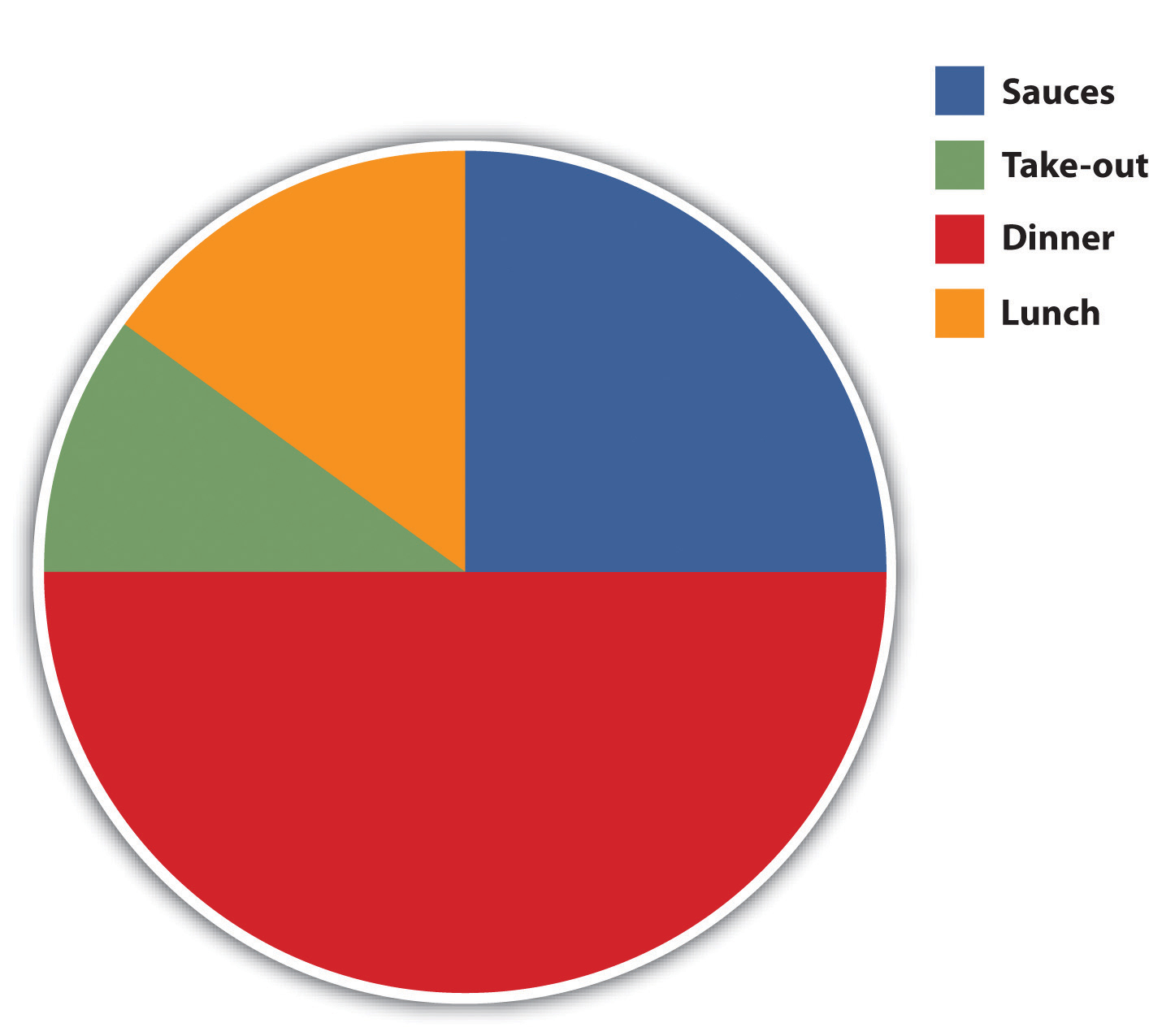
Market Needs
We believe that the market centers on excellent barbecue food served at reasonable prices and served in a family-friendly manner. We further believe that a growing segment of the market will want prepared meals that can be conveniently picked up and served at home. “Market Analysis” provides a projected breakdown of the potential customers for the next five years. This breakdown is predicated on the type of meals served and includes the sale of sauces. We provide estimated growth rates and forecasted sale of meals (and bottles of sauces) for the period 2011 to 2015. “Market Analysis” shows the breakdown of the number of meals by type in 2015.
Web Plan Summary
Presently, Frank’s All-American BarBeQue has a very simple website. The website provides minimal information—listing some of the menu items and the restaurant’s telephone number. It was created eight years ago by a college student who was working at Frank’s.
Robert Rainsford’s professional expertise is in the area of website development. After graduating from college, Robert was hired by a firm that specialized in developing web and social media presences for other companies. He worked for that firm in New York City for seven years. Robert rose rapidly through the company’s ranks, eventually becoming one of its vice presidents. His expertise in this area will enable Frank’s All-American BarBeQue to significantly enhance its web presence. Rather than just having a website that identifies the restaurant’s location and telephone number, along with a brief summary of its menu, the new website will be far richer in content and capability. It will provide a complete menu listing, identifying all items with corresponding images. The new website will enable customers to place orders through the Internet for lunch, dinner, or takeout items. The section devoted to takeout items will enable a customer to purchase prepared meals or choose from all items on the menu to develop a prepackaged meal. Customers will be able to identify the time that they will arrive for the pickup.
The website will have links to the Facebook and Twitter accounts of Frank’s All-American BarBeQue. These connections will enhance its social media presence. Customers will be asked to post comments about their dining experience and suggestions on how Frank’s can improve its operations and service. It will enable Frank’s to expand operations and still maintain the same close customer relationship that currently exists at the Fairfield restaurant.
Website Marketing Strategy
The new web presence for Frank’s All-American BarBeQue will be geared to developing a new level of customer relationships. Customers at both restaurants will be asked to fill out forms where they will supply an e-mail address and a birthdate. (This information can also be supplied through Frank’s new website.) This information will enable Frank’s to keep customers informed of specials and offer coupons and the new rewards card program for special occasions, such as holidays or birthdays.
We view the website of Frank’s All-American BarBeQue as a major component of enhancing our relationship with our customers. It should provide convenience to customers through their ability to see what is on the menu, identify new specials, and order meals and pick them up at their convenience. The use of social media will expand awareness of Frank’s and enable it to develop closer relationships with present and future customers.
Development Requirements
Robert Rainsford tapped into his expertise in social media and has already developed a far more sophisticated website for Frank’s All-American BarBeQue. He has secured the necessary server capacity to handle additional traffic on the website. In addition, he has set up several social media accounts for Frank’s All-American BarBeQue, including Facebook and Twitter. Robert also created a program linked to a database that will monitor customer purchases through the rewards card program. This program will send out birthday notices and discounts to customers and will inform them of their current status in the rewards card program.
Robert contacted several former colleagues at his former place of employment and has identified several candidates for the role of website manager. This individual will be responsible for updating the website and the social media sites on a daily basis. He or she will also be responsible for analyzing the flow of information that comes through these sites and preparing management reports.
Strategy and Implementation Summary
The core strategy of Frank’s All-American BarBeQue is to continue what has made it a success at a new location. Simply put, our strategy is to provide our customers with the finest barbecue food in Connecticut, at reasonable prices, in a family-friendly environment. In addition, we hope to improve our ability to meet customer needs by making life more convenient for our customers. We believe that these fundamentals are universally applicable.
SWOT Analysis
A strengths, weaknesses, opportunities, and threats (SWOT) analysis was undertaken for Frank’s All-American BarBeQue.
The key strength of Frank’s All-American BarBeQue is the quality of its food and service. It has been the recipient of numerous local and national awards for its foods and sauces. Other strengths include a highly knowledgeable management team with expertise in operating a barbecue restaurant, a close working relationship with suppliers of premier cuts of meats, and a loyal clientele in the south shore region.
The weaknesses associated with this business plan center on operating an additional restaurant with a much larger capacity than the Fairfield, Connecticut, restaurant. The second location will require an experienced restaurant manager. This plan calls for a significant increase in prepared (takeout) meals. Orders will be placed either by phone or through the website. Current personnel have little experience in ratcheting up the takeout portion of the business.
Opportunities
This business plan offers significant opportunities for Frank’s All-American BarBeQue. A second, larger location will translate into a significant increase in sales. Finalizing a business relationship with the regional supermarket chain will enable Frank’s to significantly increase the production and the sales of its signature sauces. The sales of sauces are expected to increase by 20 percent per year for the next five years.
Any expansion with the opening of a new location always entails some risk. The principals of Frank’s All-American BarBeQue will be investing a significant amount of capital and will be borrowing money from a bank to open a second location. It is strongly believed that the second location will capitalize on the success of the Fairfield restaurant and will become a success.
Competitive Edge
The competitive edge of Frank’s All-American BarBeQue resides mainly in the quality of its food and its commitment to serve the food in a family-friendly environment. The quality of its food is unmatched in the entire state. No other barbecue restaurant has received the awards and the accolades that Frank’s All-American BarBeQue has received for the past forty years. Its reputation for quality gives it an edge that no other barbecue restaurant or chain can match.
Marketing Strategy
The target market for Frank’s All-American BarBeQue is essentially suburban families in the south shore region of Connecticut. These people appreciate the finest barbecue food at reasonable prices. It is expected that an important group within this target market will be families with two incomes whose busy schedules would make prepared meals a very attractive option. We further assume that this market is technically sophisticated and will appreciate the convenience of ordering these meals via the Internet.
A key component of the marketing strategy of Frank’s All-American BarBeQue is to use the Internet and technology to enhance the relationship with its customer base. Frank’s will use the website, Facebook, Twitter, and e-mails to inform customers of special food items or discounts based on holidays and customers’ birthdays. We intend to use the website as a mechanism to gain an improved insight into customer needs and wants.
Frank’s All-American BarBeQue will also initiate a rewards card program. Customers will sign up for the rewards card program either at the two locations or online. They can use this program every time they make a purchase either at the restaurants or online. After a set number of visits (seven), customers will be entitled to either discounts or free items. The rewards card program will enable Frank’s All-American BarBeQue to track customers’ buying patterns and anticipate the ways in which they can better serve their customers.
Sales Forecasts
We provide a five-year forecast of the dollar value of sales broken down by the two restaurants and the sauces in the following tables. “Sales”Monthly Sales for Two Restaurants and Sauces” illustrates a forecast for the breakdown of sales on monthly basis in 2011, and “Five-Year Forecast of Sales for Two Restaurants and Sauces” illustrates the breakdown of sales for the next five years.
Sales Forecast
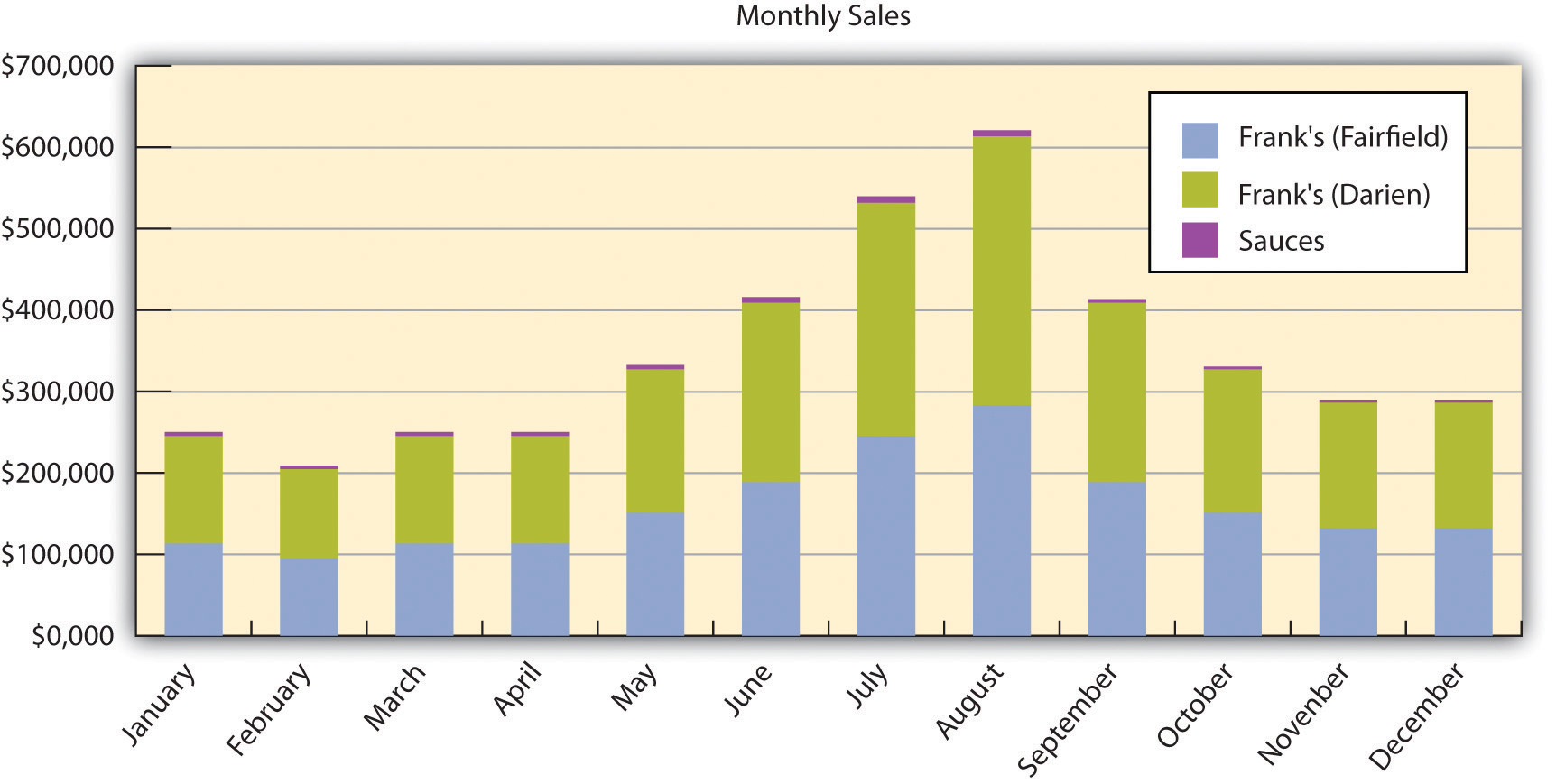

Management Summary
Currently, Frank Rainsford is the CEO and chief operating officer of Frank’s All-American BarBeQue. He is also the restaurant manager at the Fairfield restaurant. During the week, his daughter (Susan Rainsford Rogers) often replaces Frank as the restaurant manager. The Fairfield restaurant has a full-time cook who operates under Frank’s supervision, and two other full-time employees function as waiters and waitresses. These full-time employees are supplemented by six part-time employees.
Under the new management structure, Frank Rainsford will hold the position of CEO. His wife, Betty Rainsford, will be designated the president and chief operating officer. Their daughter, Susan Rainsford Rogers, will be given the title vice president for operations. She will be responsible for the day-to-day operations of the Darien, Connecticut, restaurant. Robert Rainsford will have the title of vice president of marketing. He will be responsible for all marketing activities and the operation of the website. Alice Jacobs will be the vice president of finance and the comptroller of Frank’s All-American BarBeQue.
Organizational Structure
The new management structure of Frank’s All-American BarBeQue is a basic functional layout appropriate for this type of business.
Organizational Chart
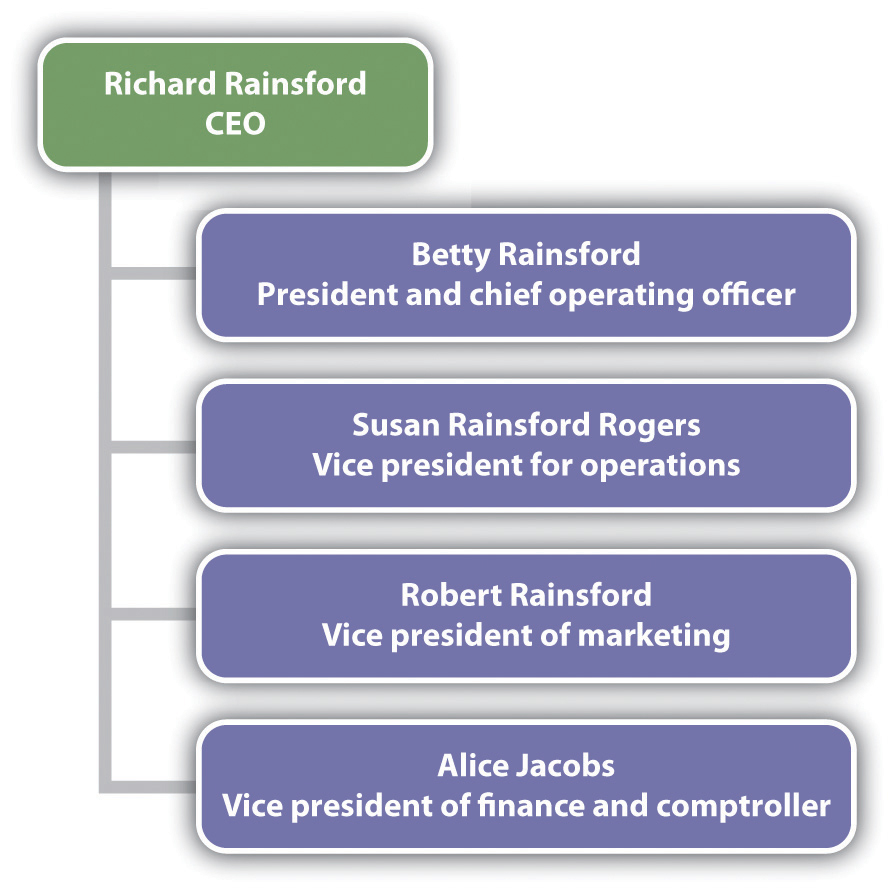
Personnel Plan
“Forecasts of Personnel” is a five-year breakdown of the types and costs of personnel.
Forecasts of Personnel
Financial Plan
Frank’s All-American BarBeQue will be financing the creation of a second restaurant through a combination of private investment and a bank loan. The private investment will raise $160,000, and Frank’s will seek another $175,000 as a two-year loan. These funds will be used to pay for equipment and leasing expenses associated with opening a second restaurant.
Important Assumptions
The assumptions associated with the grow rates of sales each year for the next five years are the keys to the financial planning process. We began with very modest assumptions of 8 percent growth in lunch sales and 5 percent growth in dinner sales. We anticipate fairly vigorous growth in takeout meals (20 percent) and sauces (15 percent). Although these are large growth rates, we do not feel that they are unrealistic.
Key Financial Indicators
“Key Financial Indicators” provides historical (2008–2010) and forecasted (2011–2015) values for the key financial indicators.
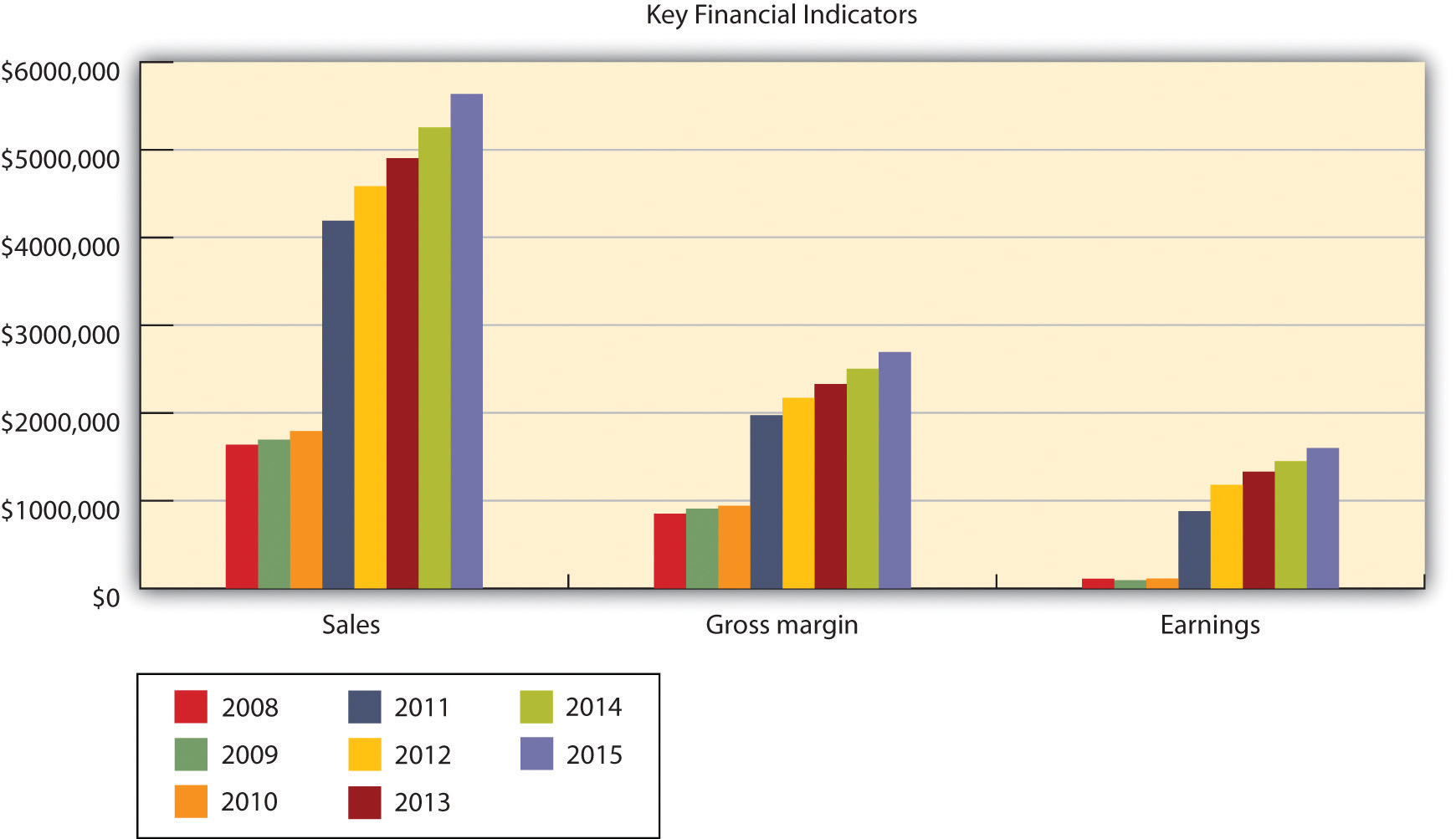
Breakeven Analysis
In “Breakeven Analysis 1” and “Breakeven Analysis 2”, we show the results of our breakeven analysis for Frank’s All-American BarBeQue. The results indicate that with sales of approximately $110,000 each month, Frank’s All-American BarBeQue will break even.
Breakeven Analysis 1
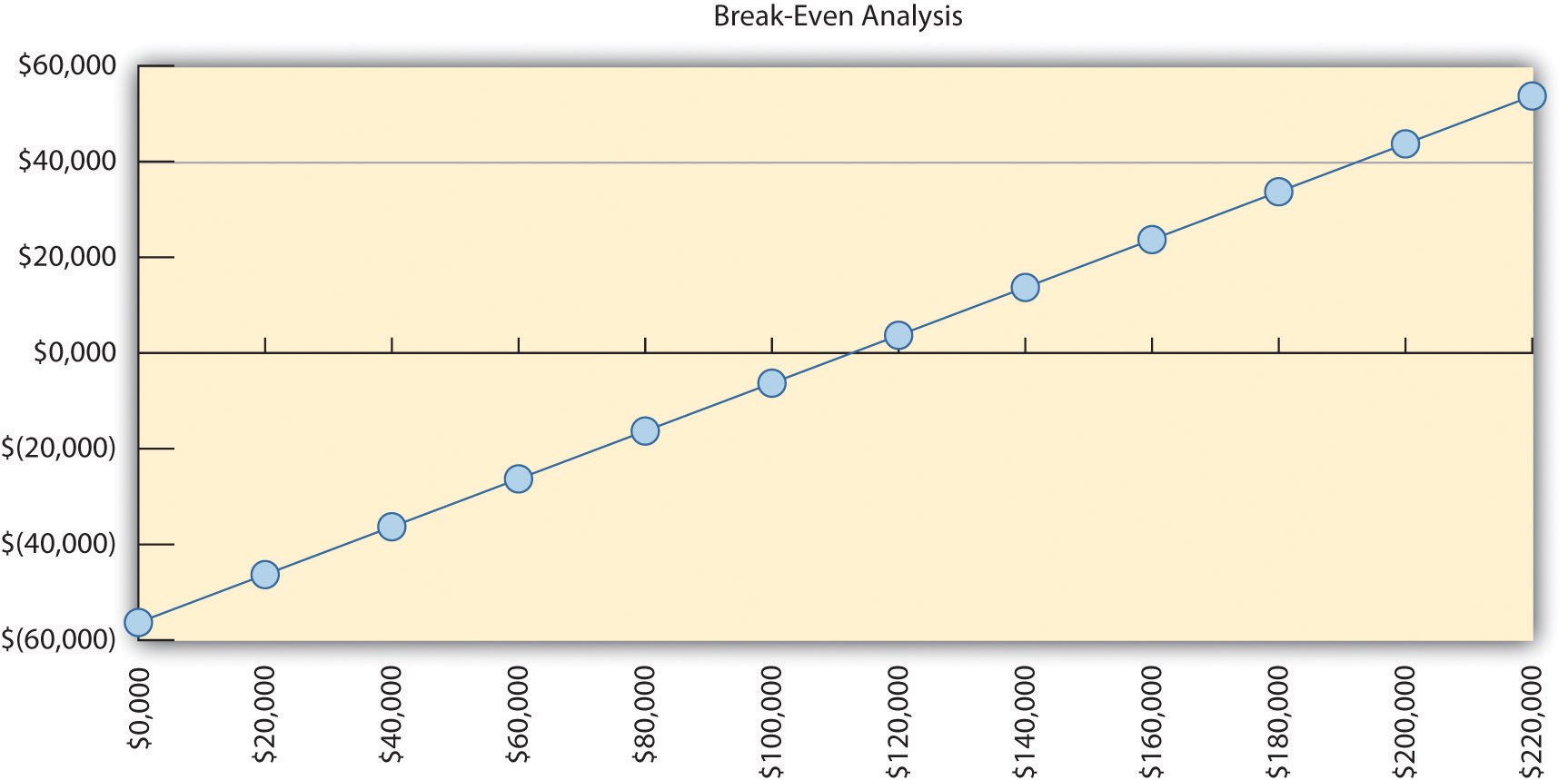
Projected Profit and Loss
Our analysis anticipates significant growth in profits in the next five years with the opening of a second Frank’s All-American BarBeQue in Darien. The profit margins should increase from in excess of $850,000 in 2011 to nearly $1,600,000 by 2015 and should be in excess of 20 percent for all five years. A complete analysis of the profit and loss statements is in “Profit and Loss”. The annual profits are illustrated in “Yearly Profits”.
Profit and Loss
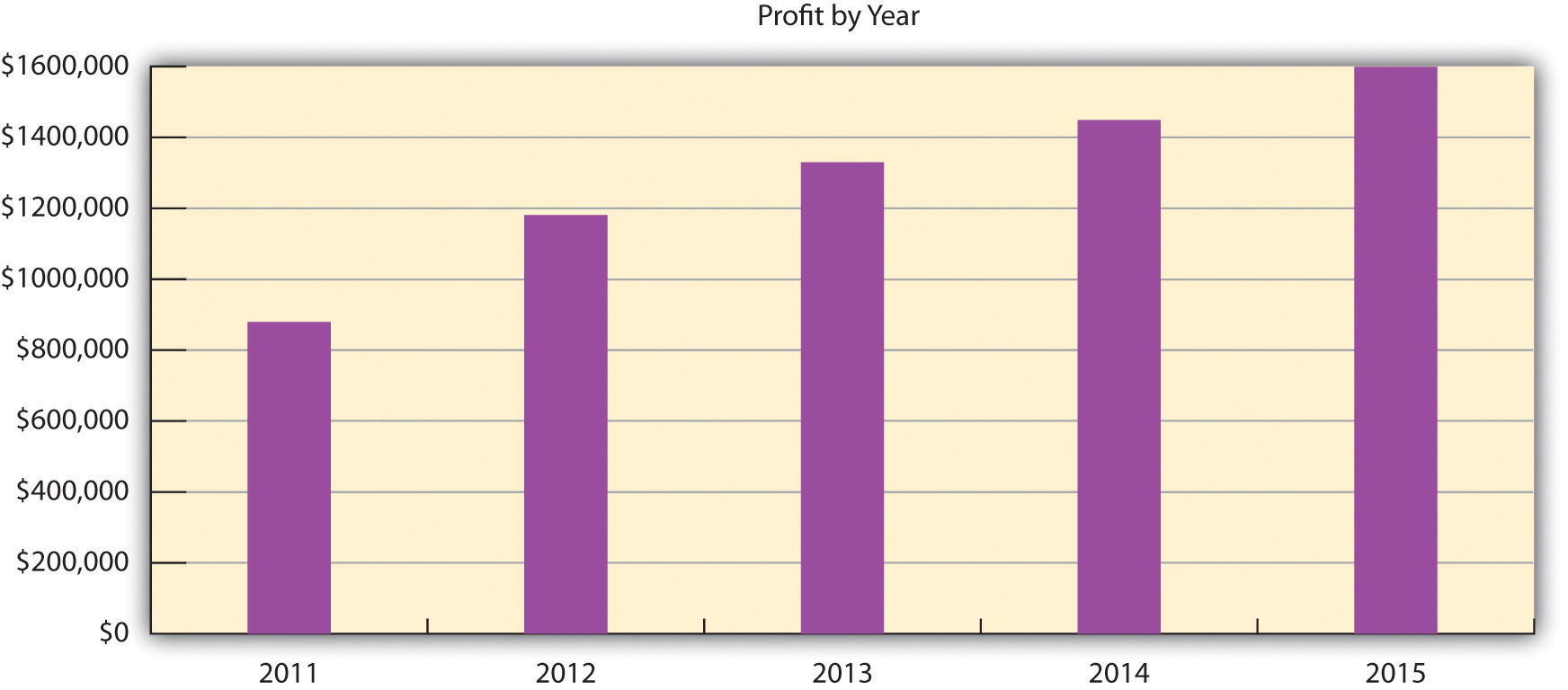
Projected Cash Flow
“Cash Flow Forecast” is a five-year forecast of cash flows for Frank’s All-American BarBeQue. The forecast shows extremely strong and positive cash flows for each year.
Cash Flow Forecast
Projected Balance Sheet
“Balance Sheet Forecast” is a balance sheet forecast for Frank’s All-American BarBeQue.
Balance Sheet Forecast
These figures clearly demonstrate that the proposed opening of a second restaurant is more than economically viable; it is an extremely lucrative project that promises to increase the net worth of the firm by 500 percent in five years.
Small Business Management Copyright © by Jason Anderson is licensed under a Creative Commons Attribution-NonCommercial-ShareAlike 4.0 International License , except where otherwise noted.
Share This Book
What to Include in Your Business Plan Appendix
In the meticulous process of drafting a business plan, the appendix often plays an underestimated yet pivotal role. What are appendices? This segment, known as the “appendix in business plan”, serves as a reservoir for critical supporting documents and data. Far from being a mere afterthought, it is an integral component that complements the main content, offering in-depth details that investors and stakeholders might seek.
Understanding what is an appendix in a business plan is key to leveraging its full potential. It’s a section where you house vital information which, while not central to the plan’s narrative, is essential for substantiating your strategies and projections.
Moreover, the purpose of including supporting documents in a business plan is to represent the robustness of your research, the depth of your planning, and your readiness for the challenges of the entrepreneurial journey.
Therefore, in this guide, we will delve deep into the art and science of curating a well-structured and comprehensive business plan appendix. We’ll explore what goes into an appendix, how to organize an appendix effectively, and why a meticulously crafted appendix can be a game-changer for your business venture.
What Goes in An Appendix?
Aside from thinking of how to make an appendix , businesses also often wonder what to include in an appendix when developing a business plan. To answer this common query, this section is where you provide the supplementary material that validates your business plan. Let’s dissect the essential contents that form the backbone of a robust business plan appendix section. The appendix of a business plan might include:
- Detailed Financial Projections: As a cornerstone of appendices in business plan, this includes comprehensive revenue forecasts , cash flow statements , and break-even analysis. These documents elevate your financial strategy from theory to actionable insights.
- Market Research Data: Your business plan appendix example isn’t complete without the data that underscores your market understanding . Include demographic studies, industry analysis, and competitive landscape assessments.
- Resumes of Key Personnel: Illustrate the strength of your team by including detailed resumes. This section answers what goes in the appendix from a human resource perspective, showcasing the expertise and experience driving your business.
- Product or Service Descriptions: Here, an appendix document example involves detailed information about your products or services. This can include brochures, technical specifications, and product development plans.
- Legal Documents: Integral to what should be included in an appendix, this encompasses licenses, permits, patents, trademarks, and any other legal paperwork that is pertinent to your business operations.
- Supporting Letters: The appendix of a business plan includes any endorsements from key stakeholders, such as letters of intent from potential customers or testimonials from partners, adding credibility to your plan.
- Additional Operational Information: This might cover the appendix business plan example components like your organizational chart, facilities descriptions, and equipment listings, depending on the nature of your business.
- Marketing Materials and Strategies: These documents outline your marketing plan appendix. Marketing documentation typically includes advertising samples, press releases, and digital marketing strategies , all vital in illustrating how you intend to capture and grow your market share.
The Don’ts of a Business Plan Appendix
When crafting a business plan appendix, understanding the elements that should not be included is as crucial as knowing what to put in an appendix. The appendix should not be a dumping ground for all information. Avoid overloading it with irrelevant or redundant documents that do not directly support your business strategy .
For instance, what information should not be included in a business plan typically extends to outdated financial statements, overly technical jargon without clear explanations, and any personal or confidential information not pertinent to the business goals.
Additionally, avoid including excessively lengthy documents; the appendix in documents should complement your plan, not overshadow it. Remember, every page in your appendix should have a purpose and add value to your business plan, helping the reader understand and evaluate your business proposition effectively, without unnecessary clutter or distractions.
Understanding why a comprehensive and well-structured appendix is pivotal to business plans is key to elevating your strategy. Why do reports frequently include appendices? The appendix of a report is not just an add-on but a strategic tool that enhances the credibility and depth of your business plan. Business appendix writing should provide essential, supporting details in an organized and accessible way, complementing your vision and illustrating the thoroughness and feasibility of your proposal.
Keep in mind, the appendix is a valuable but optional section of your business plan. There’s no need to stress excessively about its contents. As you develop your plan, simply earmark any pertinent documents or data for inclusion in your appendix.
Struggling with the complexities of crafting your business plan? Get a head start with our no-cost, comprehensive business plan template . It comes complete with a predefined structure that simplifies organizing and presenting your supporting documents effectively.
Not entirely sure what to include in your business plan appendix? In a landscape where precision and foresight are invaluable, let BSBCON help you turn your business plan into a compelling and comprehensive guide to your business’s future.
How can we help you?
Get in touch with us or visit our office
Business Plan Section 9: Appendix
The appendix section of your business plan provides information to support the 8 preceding sections. Here’s how to organize the appendix.

By now, we hope you’ve read through our series on business planning and have reached this final installment, which is what to include in Business Plan Section 9: Appendix. Think of your business plan as the narrative that tells the story, while the appendix is where you put the factual information that supports it. The appendix fleshes things out with details that help corroborate and support the plan you have presented.
Maybe you’re wondering why, if each of the preceding sections is covered so thoroughly, you even need an appendix. Why wouldn’t you just include all the information in the appropriate section? The appendix makes the rest of the plan easier to read, without taking a detour for credentials and corroboration.
In addition, your business plan can serve several different functions, and each requires a different set of documentation. Your plan can serve as a roadmap for your internal planning purposes only, it can be a recruitment tool for employees or investors, or it can support a request for funding from a financial institution. Each of these would require different documentation, and in many cases, you might not want to share some of the information with everyone. Having an appendix allows you to insert and remove items depending on who will be reading your plan.
What Goes Into Business Plan Appendix?
Again, not everything might need to be shown to everyone who reads your plan, but here is a full list of items you might want to prepare for your appendix:
- Credit histories for both the business and its owners
- Business and personal tax returns
- Resumes of the owners and key management
- Photos of your products or their prototypes
- Samples of marketing materials, logos, and mockup ads
- Reference letters from business associates and community leaders
- Details of your market research studies
- Information about your competitors
- Press clippings about you and the business
- Any relevant news articles on your product or industry
- Legal documents such as your incorporation papers, shareholder certificates, etc.
- Copies of patents, permits or licenses you hold
- Copies of your property and equipment leases or rental agreements
- Contact info for your professional staff, including your accountant and attorney
- Contracts for current or future work
- Spreadsheets and documentation for financial projections
The appendix will be the final section of your business plan, and just as with every other part, take the time to meticulously prepare these supporting materials, especially if you’re presenting the information to a potential lender or investor . The care and thoroughness you put into your backup documents will be a big clue to your readers about your general approach to business and could help sway opinion one way or the other.
The Small Business Administration suggests keeping a record of who has copies of your plan and what items you’ve included in the appendix. That way, you can update items as necessary. Do keep tight control over who you distribute it to. You may want to consider having your readers sign a Non-Disclosure Agreement, or NDA, to help protect the confidentiality of your information. SCORE, the Service Corps of Retired Executives, has a free template on its website.
And again, because of the highly privileged nature of some of what you’re providing, be very particular who you share what with. Creditors will likely need to have access to all of your documentation, but more casual readers, who might just want a bit of information about your business, don’t need to see the appendix at all, or at most, just a few select items.
How to Organize a Business Plan Appendix
Because the documents substantiate the information presented in your business plan, it’s best to keep them in the same order as they are referred to in the plan. If you have more than a few pages of documentation in the appendix, start with a table of contents page that lists each section of the business plan, broken up with letters or Roman numerals; then list each item you’ve included in the appendix for that particular section.
This will make it easier to refer to the items as you need to in the plan. For example, when you talk about your planned advertising campaign in the Sales and Marketing section, you can refer to “Appendix, Section IV” for copies of what the ads may look like.
If the appendix contains a lot of material, you can also consider using tabs to break it up, which will make it even easier to locate things. Have each document clearly labeled so readers will know exactly what they’re looking at when they refer to them, and make sure your copies are high quality, clear and legible. Do not include original documents.
Business Plan Recap
Don’t rush through the work of putting your business plan together. Whether it’s for your own use or a lender has asked for it, the information it contains and the work you do to put it together will be extremely valuable to the success of your company. It does take a lot of time and effort to research and write a solid plan, but it will come back to you in spades.
A business plan follows a specific format, so follow the guidelines we’ve set out for you in the following articles:
- Business Plans 101
- Section 1: Business Plan Executive Summary
- Section 2: Business Plan Company Description
- Section 3: Business Plan Organization and Management
- Section 4: Business Plan Products and Services
- Section 5: Business Plan Market Analysis
- Section 6: Business Plan Sales and Marketing
- Section 7: Business Plan Funding Request
- Section 8: Business Plan Financial Plan
- Section 9: Business Plan Appendix
If you’ve already read the series, you’ve heard this before: it’s imperative to always keep your audience in mind. Your goals for what you want the business plan to accomplish will dictate who your audience is, and the information you present will be shaped by that.
Finally, remember the importance of presentation. This is a reflection on you and your business, so make sure it represents you well. Proofread and check for errors in grammar and spelling. Consider hiring a writer or editor if you’re not particularly skilled with words. The business concept is yours, but a professional can help you articulate it in a way you may not be able to.
Use a standard business font for the body copy so that it’s easy to read, and be judicious in your use of italics, underlining, and bold. Business News Daily offers links to several free templates you can check out. You can follow one to put your plan together or just look at them for ideas that might work for you. There is also software available that can walk you through the process.
Have the plan printed on good paper and bind it in some fashion, whether into a booklet, in a high-quality binder or spiral binding. Add a cover with the name of your business and make sure to have your contact information easily available. Include a cover letter with the plan, because it may get passed around to other people who aren’t as familiar with your venture.
Remember the old adage, “You only get one chance to make a first impression.” Make yours count.
Elevate your learning
When it comes to your finances, you want clear guidance and easy to implement tools based on your unique needs. Visit Learn with AOF to get started strengthening your financial management and meeting your goals.
Experience a different kind of financial education. Learn with AOF has flexible, on-demand courses developed by small business owners, for small business owners. Learn on your schedule, with no time commitment or limit. Save your progress any time to fit courses into your busy schedule.
Next Article: 5 Tips for Sticking to Your Business Plan
Apply for a loan, get started.
Loans from $5,000 - $100,000 with transparent terms and no prepayment penalty. Tell us a little about yourself, your business and receive your quote in minutes without impacting your credit score.
Thanks for applying!
Loans are originated and funded through our lending arm, Accion Opportunity Fund Community Development. By clicking “Continue to Application,” you consent to, Accion Opportunity Fund Community Development’s Terms of Use and Privacy Policy ; and to receive emails, calls and texts , potentially for marketing purposes, including autodialed or pre-recorded calls. You may opt out of receiving certain communications as provided in our Privacy Policy .
What to include in a Business Plan Appendix?

Business Plan Template
- May 2, 2024

A business plan appendix is a great way to add depth to your business plan without making it unbearably long and boring.
However, not everyone needs it. And even when you do, it’s important to understand what this section entails and how you can make it useful.
Well, we will figure that out in this blog post.
But before that, what exactly is an appendix in a business plan?
What is a business plan appendix?
A business plan appendix is the last section of your business plan that contains supplementary information and documents to support the claims your plan makes.
This may include a couple of technical documents, detailed financial statements, charts, spreadsheets, and other additional documents that were too detailed or extensive to include within the main sections.
It’s like a reference point for readers who want to gather detailed insights about the information you presented in your business plan.
Let’s understand what the business plan appendix includes in brief detail:
What to include in the appendix of a business plan?
Depending on your business needs and the intended audience for your business plan, the appendix section may include some of these documents.
- Supplementary information
- Legal documents
- Organizational and personnel details
- Additional financial documents
- Achievements and testimonials
Let’s understand what the appendix business plan includes in brief detail:
1. Supplementary information
Here, you can include documents to support and elaborate on some information mentioned in other sections of your business plan.
Some examples of supplementary information include,
- Charts, graphs, and tables used in the analysis
- Sales and marketing material
- Website and social media documentation
- Raw data, research methods, and research protocols
- Questionnaires and survey instruments
- Product blueprints and images
- Technical and user documentation
- Detailed competitor analysis
- Property designs
2. Legal documents
Adding legal and compliance documents to your appendix will demonstrate your adherence to regulations and legal standards. Such transparency will help win the trust of your stakeholders and potential investors.
Here are a few examples of the kinds of legal documents you can add.
- Incorporation papers
- Licenses and Permits
- Intellectual properties, i.e. trademarks, copyright, patents.
- Building permits and rental agreements
- Supplier and vendor contracts
- Equipment documentation
- Stock certificates
3. Organizational and personnel details
In this section, you will offer information that will let readers have a peek into the workings of your company and the people behind it. Some of these documents include
- Organizational chart
- Job descriptions and hiring procedures
- Resumes for executive positions
- Certifications and degrees
- Affiliates such as attorneys or accountants
4. Additional financial documents
The main body of your financial plan already includes adequate financial information. However, depending on your audience, they might need access to certain additional information such as:
- List of assets within the business
- Credit history
- Business and personal tax returns
- Spreadsheets of financial projections
- Historical and current financial statements
- Equity structure and debt repayment plan
- SBA (Small Business Administration) loan agreements and business loans.
5. Achievements and testimonials
Lastly, you can include proof of achievements that can help establish your brand’s credibility and performance. This is a great place to highlight:
- Media and press clippings
- Testimonials and success stories
- Expert endorsements
- Awards and achievements
And those are pretty much all the things you will include in your plan. Let’s now create an appendix suited for your business plan.
Tips and best practices for business plan appendix
Before you kickstart writing your appendix, we have a few tips to help you make this section more enriching.
1. Make it scannable
Keep the contents of your appendix simple and easy to navigate. If you are planning to add a variety of documents, consider adding a table of contents to help readers find what they need easily.
2. Relate to the business plan
Everything you include in your appendix should be relevant to the contents and elements of your business plan .
You can add footnotes or a link by referencing the supplementary documents to the business plan information it supports.
3. Include the confidentiality statement
If you are adding financial statements or any legally classified information, add a confidentiality statement. This is an effective way of ensuring that the parties with access to confidential information don’t share it with anyone else.
4. Keep the appendix supplementary
When you write a business plan ensure that the document stands on its own without relying on the appendix. Your readers are likely to skip this section, so you don’t want to risk having inadequate information in the main body.
Your appendix should only cover supplementary and supporting information, not any core detail that the reader must quintessentially know.
Start preparing your business plan with the appendix
Now, don’t get caught up trying to figure out what to include in your appendix. Focus on writing your business plan, and you will eventually get a gist of supporting documents essential for your plan.
However, what if you need help writing your business plan in the first place? In that case, a business planning app or sample business plans would help.
For instance, Upmetrics’ AI business plan generator can help create compelling business plans from scratch in less than 10 minutes.
All you have to do is answer some tailored business questions, and an AI assistant will do everything else for you.
Build your Business Plan Faster
with step-by-step Guidance & AI Assistance.
Frequently Asked Questions
Is the appendix important in a business plan.
Yes, the appendix is an important section of your business plan. Although it’s not compulsory, adding an appendix will help your investors and other audiences gather the required information in in-depth detail. An appendix helps you prove the viability of claims made in different sections of your plan.
How do you write an appendix for a business plan?
Follow these steps to write your appendix section:
- Gather all the supplementary documents you want to include in this section.
- Organize them logically based on the structure of your plan or their content nature, i.e. financial documents, legal documents, marketing materials, etc.
- Label the documents and present them neatly in a professional stack without creating clutter.
- Add footnotes and links to the relevant business plan sections and create a table of contents to make the information easily scannable.
Do I need a table of contents for the appendix?
It’s recommended to have a table of contents especially if you are adding multiple long documents supporting different sections of your business plan information.
Are there any online resources for creating a business plan appendix?
Business plan templates are the best resources for creating a clear and impactful appendix section. Most business plan templates online have a section for appendix which can be easily edited to suit your needs.
About the Author
Upmetrics Team
Upmetrics is the #1 business planning software that helps entrepreneurs and business owners create investment-ready business plans using AI. We regularly share business planning insights on our blog. Check out the Upmetrics blog for such interesting reads. Read more
Get started with Upmetrics Al
- 400+ sample business plans
- Al-powered financial planning
- Collaborative workspace
Reach Your Goals with Accurate Planning


- Investor Business Plan
- SBA Business Plan
- L1 Visa Business Plan
- E2 Visa Business Plan
- EB-5 Visa Business Plan
- Strategic Business Plan
- Franchise Business Plan
- Call our business plan experts:

- Schedule Free Consultation
What Are Appendices in a Business Plan? A Complete Guide
What are appendices in a business plan.
A comprehensive business plan is significant for all investors or business dreamers in the competitive business world. It serves as a roadmap to business success and gives entrepreneurs the right direction to follow at every critical stage of their venture. Similarly, one of the sections in a business plan has its place due to adding an essence to your plan. It is called “Appendices”. Do stick around to learn what are appendices in a business plan.
Appendices in a business plan are additional documents or materials that provide supplementary information to support the main content of the plan and appear as the final section. It validates that you have a robust business plan with detailed data, supporting documentation, charts, graphs, legal documents, resumes of key team members, and any other relevant information that is supposed to be presented outside the main body. It intends to enhance credibility through visuals, legal documents, and other supporting documentation, which is necessary for investors, stakeholders, or lenders to fully understand the business and its viability.
Importance of Appendices
As we know, an executive summary provides a snapshot of your overall plan, whereas including a well-rounded section, such as a business plan appendix, serves as the cherry on top, exuding a sense of professionalism and preparedness that should not be ignored and must be kept digestible.
Ensure you have added anything in the appendix that is relevant to the rest of your business plan. It should be separate from the materials you’ve already covered elsewhere.
You are referencing the portion of your strategy that the data in your appendix supports can be helpful. If your business strategy is digital, include connections to other sections or use footnotes. If you need to learn how to do this, you can get assistance from a Professional business plan writer .
Your appendix is an optional supporting section of your business plan and does not necessarily need to be included.
However, this section may become an opportunity for you to score extra points and solidify the quality of your business plan design.
For instance, Immigration business plan writer in our company are highly experienced and promise to deliver a business plan that guarantees meeting all the requirements of USCIS. For Business plan writing cost , you can visit our website now.
Let’s further discuss each component one by one.
The common material that you can include in the appendices section of a business plan are described below.
Financial Statements : Like presenting financial projections, including income statements, balance sheets, and cash flow descriptions. Market Research : In-depth market research data, surveys, and reports provide insights into the industry, target market, and competition. Supporting Documentation : Any legal documents such as contracts, patents, licenses, permits, or other necessary paperwork relevant to the business. Resumes : Detailed resumes or profiles of prominent team members, including founders, executives, and advisors. Charts and Graphs : Visual data demonstration, such as market trends, sales projections, or organizational structure. Product or Service Information : Describe specifications in detail, designs, or technical information about the business’s products or services.
Examples of some information to add within appendices in a business plan
Here is some information you might include in your business plan appendix. Although it depends on your business plan’s niche requirements, a wide variety of items can prove beneficial for supporting your business plan. Such as
- Charts, graphs, or tables
- Financial statements and projections
- Sales and marketing materials
- Executive team resumes
- Business and/or personal tax returns
- Agreements or contracts with clients or suppliers
- License, permits, patents, and trademark documentation
- Product packaging samples
- Building permit and equipment lease documentation
- Contact numbers for attorneys, accountants, and advisors
You can include any of them in your appendix, depending on your business needs and to whom you demonstrate your business plan.
To craft a Strategic Business Plan and E2 visa business plan , what you should gather and include based on your industry—contact our team to help you through its process.
Although, our team of experts also offer Investor Business Plan services that will increase your chances of getting funded.
How to Create Effective Appendices
By meticulously organizing additional information and presenting it in the appendices, here are a few tips that will help you fit the information more appropriately in its position and assist you in catching potential investors, investors and stakeholders ‘ attention. Avoid Procrastination- Try to gather important material at hand as early as possible. You shouldn’t wait until your plan is complete, and then you start gathering your resources, as it will be time-consuming and slow down your process.
Be Mindful to cover all details – Ensure that you add relevance and coherence to the main body of the business plan; otherwise, you may go unnoticed.
Add references to locate relevant information within the section- Many organizations must pay attention to your business plan to ensure that you’re legitimate; therefore, include connections to other sections or use footnotes to avoid overloading with unnecessary details.
Keep your appendix simple and attractive – making every section count by organizing it in the same order is essential. It will serve as a guide to help locate information quickly, while the primary focus should be to ensure the plan is attractive.
Follow consistency in formatting and presentation – Another thing is to maintain the flow with a complicated mess; your readers will undoubtedly make negative assumptions if they find exaggeration and the table of contents split.
Above all is about appendices and how creating appendices can complement and supplement your main content. You should keep a balance between detail and brevity in the appendices. These additional resources you are attaching to your business plan profile should be authentic, up-to-date, well-organized, clearly labeled, and referenced appropriately within the main body of the business plan.
The appendix doesn’t just complement your strategy, it elevates its credibility and persuasiveness, reassuring your supporters that you mean business and are ready to conquer the market with confidence and authenticity.
Moreover, contact us if you’re seeking a franchise business plan writing service that can provide a comprehensive business plan that aligns with your business needs.
Q1: What type of information should be included in the appendices?
A1: Following are the type of information that should be included in your business plan appendix:
- Charts, graphs, or tables that support sections of your business plan
- Business and personal tax returns
- Agreements or contracts with clients or vendors
- License, permits, and patents
Q2: Are appendices necessary for every business plan?
A2: Not really, appendices are optional, so if you want to complement your plan, go ahead.
Q3: How should the appendices be organized within the business plan?
A3: Here is the format that generally is followed in the appendices section.
- Table of Contents
- Confidentiality Statement
- Short & Simple
Q4: Are there any best practices for formatting appendices?
A4: Appendices should be formatted in traditional paragraph style and may feature text, figures, tables, equations, or footnotes.
Q5: How many appendices should a typical business plan include?
A5: These appendices typically include financial projections, resumes of key team members, market research data, legal documents, and other relevant materials.
Leave a Reply Cancel reply
Your email address will not be published. Required fields are marked *
Save my name, email, and website in this browser for the next time I comment.
Get a Free Consultation Now
For free Consultation, please make an appointment with us by filling in the details here and Clicking on the “Submit” button. We will contact you within 24 Hours.
Confidentiality of your information is our foremost priority.
I Agree to get e-mails from BPlanWriter.

When you finish writing your business plan, you want it to make sense when someone, probably an investor or a shareholder in your business, reads it. That’s where the exhibits and appendices section comes in!
Often overlooked, the appendix section is an integral part of any business plan. Let’s imagine you are writing your business plan to woo some investors. In that case, the quality of the exhibits and appendices section in your plan will matter a lot.
The appendix offers your target readers great insights about your plan. Ideally, you should use this section to convince the investors that you have a robust business concept.
If you want your potential investors to take your business concept seriously you must invest a lot of time and research to prepare a great exhibits and appendices section for your business plan.
In this guide, we will cover everything you need to know to complete a convincing exhibits and appendices section in a business plan.
Key Takeaways
- Before completing the exhibits and appendices section in a business plan, think of what you want to achieve with your plan. This way, you know what supporting documents to include
- Key documents to include in this section are financial statements – cash flow, income statements, balance sheets, and general financial projections, market analysis, company information and background, and marketing materials and plan
- Provide detailed documentation to make it easy to convince any reader to take the desired action
- Add a table of contents for ease of navigation from one section to the other
What Is a Business Plan Exhibits and Appendices Section?
The appendix, which is the last part in a business plan, offers supporting documentation for critical components in your plan. For instance, here you include any market research analysis you’ve done and financial statements.
Additionally, if there are any charts and tables, you should capture them in the exhibits and appendices section.
You can, as well, include other information in this section such as resumes, credit history, and intellectual property documentation. However, the limit of what to capture in the appendix section should be informed by the audience you are targeting.
What’s the Purpose of the Exhibits and Appendices Section in a Business Plan?
The exhibits and appendices section in a business plan has a defined purpose. It offers evidence and supporting documentation for your business concept.
For instance, while you can include charts and graphs in the body of your business plan, they are best captured in detail in the exhibits and appendices section.
How to Complete the Exhibits and Appendices Section in a Business Plan?
Now that you know the importance of having an appendix section, the next step is learning how to complete it successfully.
The most important success factor when completing a business plan appendix is knowing what goes into this section.
Here are some of the supporting documents to include in this section:
1. Financial Projections
If you are writing a business plan for loan applications or raising capital, you better have clear and strong financial projections. Include detailed monthly, quarterly and annual cash financial projections in the appendix section.
The most critical financial information to focus on here include income statements, balance sheets, and cash flow statements.
2. List of Customers
When preparing a business plan for expansion purposes, you will need to include a list of customers. Such information gives a potential investor and shareholders a clear snap chat of your present clientele base.
3. Market Analysis
Analyzing the target market is a critical step when preparing a business plan. Whether you are starting out or expanding, you need a clear understanding of the market you are entering . Include all the relevant information about your market in the appendix section.
Some of the aspects to consider here include a clear definition of the industry, a brief description of the potential customers and competitors.
Additionally, add any potential risks you might have identified during the market research. Such information helps you make the right decisions towards achieving the set goals.
4. Marketing Materials and Plan
How do you plan to market your business concept? What materials will you need? The exhibits and appendices section is a great place to expand the marketing section you have already covered in your plan.
Here, you need to attach a detailed marketing plan. It helps convince your readers that you have a clear understanding of your target audience, where to put marketing efforts, as well as how you intend to create awareness of your business concept.
Best Practices When Completing the Exhibits and Appendices Section in a Business Plan
Crafting a successful exhibits and appendices section isn’t as easy as it sounds.
Here are a few best practices to guide you as you complete the appendix section in your business plan:
- Include a table of contents : When the appendix section covers several documents, it is advisable to include a table of contents. This way, it helps a reader access the different sections easily.
- Confidentiality Statement : where you include legal documents, intellectual property applications or diagrams, and credit history documents, ensure that you have a Confidentiality Statement. It reminds anybody reading the business plan that they should not share or disclose such information with your consent.
- Short and Simple : You have covered a lot of information about your concept in the other sections of the business plan. Ensure that you keep this section as short and simple as possible. However, it is important to provide all the necessary information to support your business plan.
Final Thoughts
As a business owner, you want to write a business plan that gets read and convinces the readers –whether they are investors or shareholders – to take some action. The exhibits and appendices section is a great place to make this possible by including all the necessary information to back up any claims in the preceding sections of your business plan.
Whereas it is important to keep the appendix section as short as possible, it is equally necessary to ensure that it covers enough documents to support your business concept. Are you stuck writing the exhibits and appendices section in your business plan? Leave us a comment below.
- Apply as a Writer
- Privacy policy
- Terms of use
- SBA business plans
- Non-profit business plans
- Startup business plans
All rights reserved by MovaslearningOU @2023

How To Write an Appendix in a Business Plan
Written by Dave Lavinsky

After taking time to write a business plan , you want it to be read. That means the body should be no more than 15 pages in length. That’s where the business plan appendix comes in!
The appendix is a supplementary section that contains additional information and supporting documents essential to the business plan, such as charts, graphs, financial statements, market research, and legal documents.
Although the final section of a comprehensive business plan , the appendix is an integral part of your plan. For example, suppose you are using your business plan to attract investors. In that case, the relevant documents in the appendix will provide greater insight and can help convince your potential investors that you’ve got a solid business concept. You’ve done the research necessary to support the claims and forecasts in your plan’s other sections.
In this article, we’ll discuss everything you need to know about the business plan appendix so that you can start developing a great appendix for your business plan.
Download our Ultimate Business Plan Template here
What is a Business Plan Appendix?
The appendix materials are used to provide additional documents that support the key components in your business plan, such as financial statements or market research.
The appendix is also a great place to put any other tables or charts you didn’t want to put in the main body of the business plan. Depending on the intended audience of your business plan, you may also want to include additional information such as intellectual property documentation, credit history, resumes, etc.
Why is the Business Plan Appendix Important?
The Appendix is used to support and give more credibility to the rest of the document. In the Appendix section, you should provide supporting evidence for key components in your business plan. While you may include charts in graphs in the body of your plan, these should be summary projections, while the fully detailed charts and tables can be found in the appendix.
What To Include in the Business Plan Appendix
Your Appendix should include any information that supports the claims in your plan such as patents, store designs, customer lists/contracts, partnership agreements, vendor contracts, etc.

Additional Financial Documents

Customer Lists

Customer Testimonials

Intellectual Property Documentation

Management Team

Leases & Customer Contracts

Building & Architectural Designs
Businesses looking to build or expand their operations will need access to building plans, architectural drawings, building permits, etc.
Finish Your Business Plan Today!
Quickly & easily complete your business plan: Download Growthink’s Ultimate Business Plan Template and finish your business plan & financial model in hours.
Some small business owners may also include the following documents in the appendix:
Company History and Background
Businesses with highly competitive landscape will need to gather detailed insights about their competition. Business plans for major businesses should have the company history section last so that you can provide additional information about your competitors or other companies that are relevant to your business plan. Businesses planning on using their business plan as an internal document can use less detail here.
Market Analysis
Your market analysis should include relevant information about how you defined your industry, potential customers and competitors, etc. Include any identifiable risks and assumptions based on your market research.
Individual & Business Credit History
If you don’t have much experience with business credit or borrowing, it might be worth adding a short explanation of your current and past financing use, including your tax returns and incorporation papers, licenses, etc. This is especially helpful if you plan to apply for a loan through the Small Business Administration (SBA).
Marketing Materials & Plan
For some entrepreneurs, the marketing section of the business plan only provides a brief overview of their marketing strategy. Attaching the complete Marketing Plan in the appendix section of your business plan helps your reader understand if you’ve thought through your target audience, where you should target your marketing efforts, and how you will advertise to them to expand awareness of your brand and sales of your products and/or services.
Best Practices for Your Business Plan Appendix
- Table of Contents : If you are including several documents in the business plan appendix, include a table of contents for your reader’s reference point.
- Confidentiality Statement : If you include credit history documents, intellectual property diagrams or applications, or any other legal documents with confidential information, have a Confidentiality Statement within the appendix to remind your readers that they are not to share or discuss the information within your plan without your written consent.
- Short & Simple : This business plan section is likely to be skipped unless your reader is looking for specific information to support a claim in your business plan. Think about your intended reader and only include what is necessary to help make your request (e.g., business partner proposal, raise funding, etc.) and support your business plan.
As a business owner, you want to keep your business plan short so that it gets read. The Business Plan Appendix is a great way to include additional information about the preceding sections without adding to the length of your document.
At Growthink, we have 20+ years of experience in developing business plans for a variety of industries. We have 100+ business plan examples for you to use as a guide to help you write your business plan. You can also get our easy-to-use business plan template to help you finish your plan in less than one day.
How to Finish Your Business Plan in 1 Day!
Don’t you wish there was a faster, easier way to finish your business plan?
With Growthink’s Ultimate Business Plan Template you can finish your plan in just 8 hours or less!


IMAGES
COMMENTS
The appendix is the perfect place to showcase a wide range of information, including: Supporting documentation: References and supporting evidence to substantiate any major projections, claims, statements, decisions, assumptions, analysis, trends and comparisons mentioned throughout the main body of a business plan. Requested documentation: Information, documents or other materials that were ...
Business plan appendix best practices. Here are a few tips to help you create an appendix for your business plan. Make it easy to navigate. If your business plan appendix is more than a few pages long or contains a variety of documents, you may want to consider adding a separate table of contents. Don't forget security
An appendix in a business plan is a supplementary section that provides additional information to support the main body of content of the plan. It includes documents, charts, graphs, and other relevant materials that can help clarify or provide evidence for the statements made in the business plan.
Appendix: A Sample Business Plan. The following business plan for Frank's All-American BarBeQue was built using Business Plan Pro software. It is for the purpose of illustration and does not represent the full capabilities of the software. ... This business plan offers significant opportunities for Frank's All-American BarBeQue. A second ...
Let's dissect the essential contents that form the backbone of a robust business plan appendix section. The appendix of a business plan might include: Detailed Financial Projections: As a cornerstone of appendices in business plan, this includes comprehensive revenue forecasts, cash flow statements, and break-even analysis. These documents ...
The appendix will be the final section of your business plan, and just as with every other part, take the time to meticulously prepare these supporting materials, especially if you're presenting the information to a potential lender or investor. The care and thoroughness you put into your backup documents will be a big clue to your readers ...
A business plan appendix is the last section of your business plan that contains supplementary information and documents to support the claims your plan makes. This may include a couple of technical documents, detailed financial statements, charts, spreadsheets, and other additional documents that were too detailed or extensive to include ...
A1: Following are the type of information that should be included in your business plan appendix: Charts, graphs, or tables that support sections of your business plan; Sales and marketing materials; Executive team resumes; Business and personal tax returns; Agreements or contracts with clients or vendors; License, permits, and patents
Often overlooked, the appendix section is an integral part of any business plan. Let's imagine you are writing your business plan to woo some investors. In that case, the quality of the exhibits and appendices section in your plan will matter a lot. The appendix offers your target readers great insights about your plan.
After taking time to write a business plan, you want it to be read.That means the body should be no more than 15 pages in length. That's where the business plan appendix comes in! The appendix is a supplementary section that contains additional information and supporting documents essential to the business plan, such as charts, graphs, financial statements, market research, and legal documents.